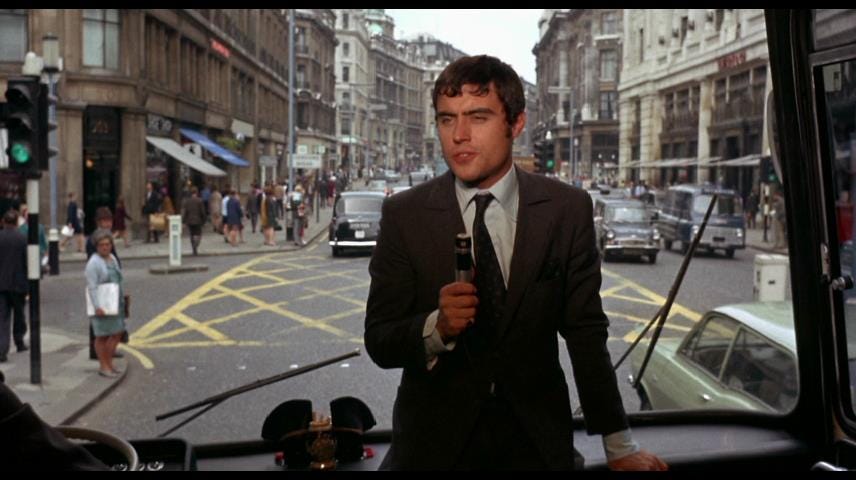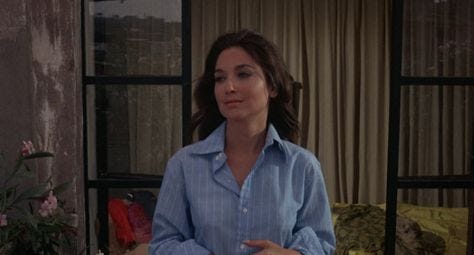Nostalgia Tour
On "If It's Tuesday, This Must Be Belgium" and the cheesiness of memory. Plus: Criterion Channel must-sees.

Sometimes it’s comforting to revisit not the great films of one’s youth but the junk. Not actual bad movies but the disposable commercial flotsam, the product that has no thought of art or even a long shelf life.
Movies like “If It’s Tuesday, This Must Be Belgium.”
On New Year’s Eve, my wife and I were huddled up in an AirBnB in Maine with two longtime friends, all of us tested and fed and gently cocktailed, and somehow that 1969 comedy about American tourists racing through nine countries in Europe came up in the conversation. We could have watched any of the award-worthy films of 2021 before we rang in 2022, but the mood was for the comfort food of nostalgia, so I dialed the movie up on Paramount+ and away we went (it’s also available via DirecTV, Epix, and Hoopla).
I was 12 in 1969; for reasons lost to the mists of time I saw “If It’s Tuesday, This Must Be Belgium” twice in theaters that year. Perhaps that’s why the movie imprinted itself on my memory — to the point where I was able to recall scenes in their entirety decades on — even as I was registering that this may not have been one for the ages. Seeing it again 52 years later turned out to be an immensely pleasurable experience, because the film really didn’t have much to live up to. It just had to be its hokey, swinging-60s self, and it was.

It’s the sort of movie that stops dead for Donovan singing a song in a hippie crash pad. It casts an impossibly young Ian McShane (above) – the leather-skinned Al Swearingen of HBO’s “Deadwood” – as a London dandy of a tour guide and a coolly sensual Suzanne Pleshette, halfway between “The Birds” and Bob Newhart, as his romantic interest, a young American businesswoman on holiday. Better yet, the movie features a raft of character actors familiar from movies and TV shows of the era, each face a little lollipop of remembrance. Look, there’s Norman Fell from “Three’s Company” as the man who loses his wife (Reva Rose) when she gets on the wrong tour bus. Murray Hamilton, soon to gain infamy as the mayor of Amity Island in “Jaws,” as a crass family man ordering loafers from an Italian shoemaker played by the great neorealist filmmaker Vittorio De Sica. Michael Constantine, who passed away last August and is best remembered as the Windex-wielding patriarch of “My Big Fat Greek Wedding,” cast as an ex-GI revisiting a wartime lover. Marty Ingels and Mildred Natwick and Peggy Cass and Sandy Baron – names that mean nothing to you if you’re not of the era but practically family to anyone who soaked up multiple episodes of “Mannix” and “Love, American Style” over a Swanson’s TV dinner with a nuclear-core apple cobbler.
Even the cameos are kind of mind-blowing. Wait, is that really John Cassavetes and Ben Gazzara playing poker with Constantine in an early scene? Why does Robert “Napoleon Solo” Vaughn turn up for two seconds? And if the running gag where Ingels’ wannabe ladies’ man snaps pictures of every beauty in the street plays with har-har chauvinism today, the women in question do represent a who’s who of European va-va-voom circa 1969: Virna Lisi, Anita Ekberg, Senta Berger, Catherine Spaak, Elsa Martinelli, and, yes, Joan Collins. All of this flew over my head – over all of our heads – in 1969 and was cause for happy squawks, rewinding, and checking with Wikipedia on New Year’s Eve.
The plot is simple and episodic, the jokes at the expense of Americans and Europeans broad as a barn. But the rueful party’s-over theme song has stuck in my head for a half century, and the scene where Pleshette greets the dawn wearing only McShane’s shirt was a landmark moment in the preadolescent sexual awareness of one of my friends.

To a kid at the dawn of the 1970s, in other words, this was a sophisticated movie, an armchair tour of attitudes that were coded as adult then and are almost heartbreakingly simplistic today. Coming back to a film you first saw as you were leaving childhood lets you measure the distance between the worldliness you thought was coming and the world you got. Even when it’s junk.
A few heads ups for those of you who subscribe to the Criterion Channel (and if you don’t, you should). The new three-film package devoted to the Nicholas Brothers is a great way to make or renew an acquaintance with Fayard and Harold Nicholas, two of the most astonishingly athletic dancers (see above) in Hollywood history and a duo that would have had a lot more than specialty numbers if they’d been white. There’s a big, honking French New Wave retrospective – 44 movies in all – that features all the warhorses (“Breathless,” “Jules and Jim,” “Claire’s Knee”) and lesser-known gems (“Lola,” “Zazie Dans La Metro,” “Celine and Julie Go Boating”); it’s a good starter kit for newcomers and a refresher course for old hands. And the channel’s ongoing and essential “Female Gaze: Women Directors & Women Cinematographers” festival has just been complemented by Sight and Sound’s publication of “The Female Gaze: 100 Overlooked Films By Women,” a chronological listing with commentary by well-known academics (Imogen Sara Smith), critics (Jonathan Rosenbaum, Miriam Bale), screenwriters (Kim Morgan), actors (Tilda Swinton, Isabelle Huppert), and directors (Jane Campion, Greta Gerwig, Claire Denis). In a year in which the number of women directing major movies declined from 16 percent to 12 percent, both festival and list are deep dives into an undeservedly secret history of cinema – while still representing only a tip of the iceberg.
If you enjoyed this edition of Ty Burr’s Watch List, please feel free to share it with friends.
If you’re not a paying subscriber and would like to sign up for additional postings and to join the discussions, here’s how:
If you’re already a paying subscriber, I thank you for your generous support.





